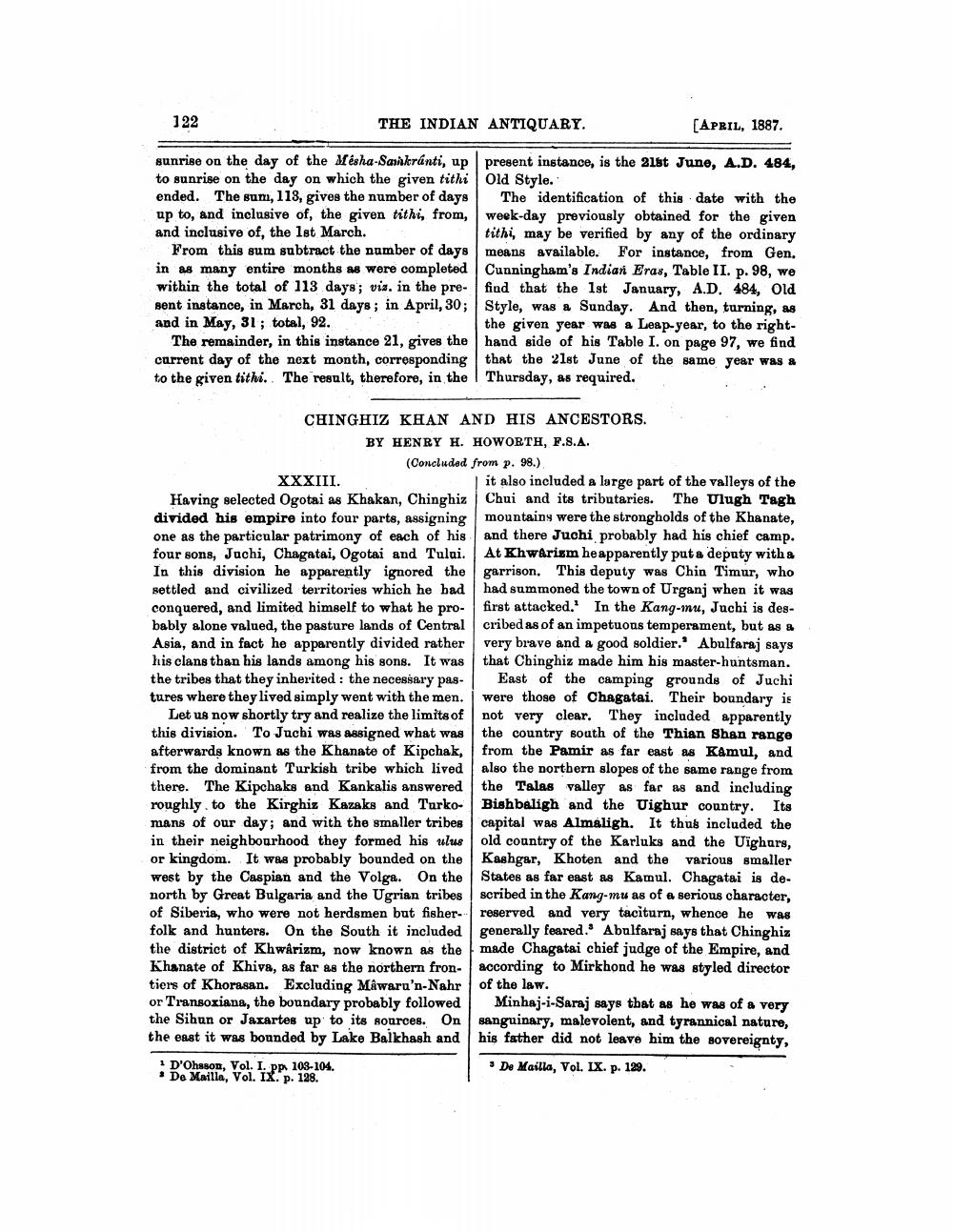________________
122
THE INDIAN ANTIQUARY.
[APRIL, 1887.
sunrise on the day of the Mésha-Sankranti, up present instance, is the 218t June, A.D. 484, to sunrise on the day on which the given tithi Old Style. ended. The sum, 118, gives the number of days The identification of this date with the up to, and inclusive of, the given tithi, from, week-day previously obtained for the given and inclusive of, the 1st March.
tithi, may be verified by any of the ordinary From this sum subtract the number of days means available. For instance, from Gen. in as many entire months as were completed Cunningham's Indian Eras, Table II. p. 98, we within the total of 113 days; vis, in the pre- find that the 1st January. A.D. 484, Old sent instance, in March, 31 days; in April, 30; Style, was a Sunday. And then, turning, as and in May, 31; total, 92.
the given year was a Leap-year, to the rightThe remainder, in this instance 21, gives the hand side of his Table I. on page 97, we find current day of the next month, corresponding that the 21st June of the same year was a to the given tithi. The result, therefore, in the Thursday, as required.
CHINGHIZ KHAN AND HIS ANCESTORS.
BY HENRY H. HOWORTH, F.S.A.
(Concluded from p. 98.). XXXIII.
it also included a large part of the valleys of the Having selected Ogotai as Khakan, Chinghiz Chui and its tributaries. The Ulugh Tagh divided his empire into four parts, assigning mountains were the strongholds of the Khanate, one as the particular patrimony of each of his and there Juchi probably had his chief camp. four sons, Jachi, Chagatai, Ogotai and Tului. At Khwariam he apparently put a deputy with & In this division he apparently ignored the garrison. This deputy was Chin Timur, who settled and civilized territories which he had had summoned the town of Urganj when it was conquered, and limited himself to what he pro- first attacked. In the Kang-mu, Juchi is desbably alone valued, the pasture lands of Central cribed as of an impetuous temperament, but as a Asia, and in fact he apparently divided rather very brave and a good soldier.' Abulfaraj says his clans than his lands among his sons. It was that Chinghiz made him his master-huntsman. the tribes that they inherited: the necessary pas- East of the camping grounds of Juchi tures where they lived simply went with the men. were those of Chagatai. Their boundary is
Let us now shortly try and realize the limits of not very clear. They included apparently this division. To Juchi was assigned what was the country south of the Thian Shan range afterwards known as the Khanate of Kipchak, from the Pamir as far east as Kamul, and from the dominant Turkish tribe which lived also the northern slopes of the same range from there. The Kipchaks and Kankalis answered the Talas valley as far as and including roughly to the Kirghiz Kazaks and Turko- Bishbaligh and the Uighur country. Its mans of our day; and with the smaller tribes capital was Almaligh. It thus included the in their neighbourhood they formed his ulus old country of the Karluks and the Uighurs, or kingdom. It was probably bounded on the Kashgar, Khoten and the various smaller west by the Caspian and the Volga. On the States as far east as Kamul. Chagatai is denorth by Great Bulgaria and the Ugrian tribes scribed in the Kang-mu as of a serious character, of Siberia, who were not herdsmen but fisher reserved and very taciturn, whence he was folk and hunters. On the South it included generally feared. Abulfaraj says that Chinghiz the district of Khwârizm, now known as the made Chagatai chief judge of the Empire, and Khanate of Khiva, as far as the northern fron-according to Mirkhond he was styled director tiers of Khorasan. Excluding Mâwaru'n-Nahr of the law. or Transoxiana, the boundary probably followed Minhaj-i-Saraj says that as he was of a very the Sihun or Jaxartes up to its sources. On sanguinary, malevolent, and tyrannical nature, the east it was bounded by Lake Balkhash and his father did not leave him the sovereignty, D'Ohsson, Vol. I. pp. 103-104.
De Mailla, Vol. IX. p. 129. • De Mailla, Vol. IX. p. 128.




